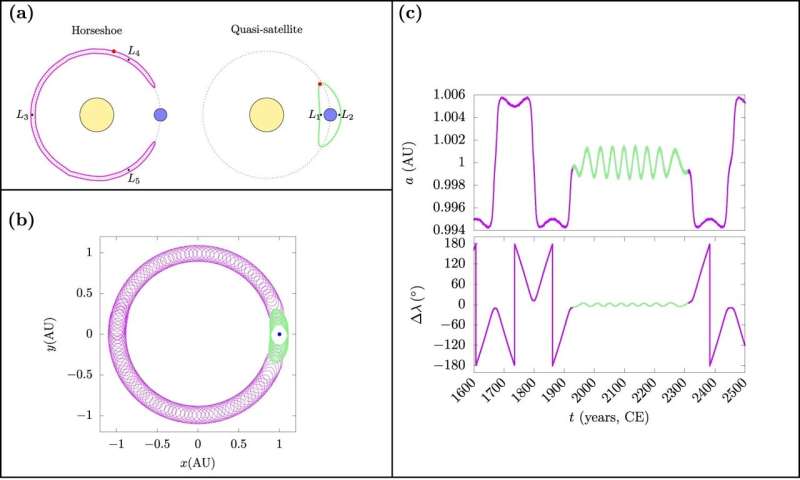This article has been reviewed according to Science X's editorial process and policies. Editors have highlighted the following attributes while ensuring the content's credibility:
fact-checked
peer-reviewed publication
trusted source
proofread
How could a piece of the moon become a near-Earth asteroid? Researchers have an answer

A team of astronomers has found a new clue that a recently discovered near-Earth asteroid, Kamo'oalewa, might be a chunk of the moon. They hypothesized that the asteroid was ejected from the lunar surface during a meteorite strike—and they found that a rare pathway could have allowed Kamo'oalewa to get into orbit around the sun while remaining close to the orbits of the Earth and the moon.
The research team details their findings in the Oct. 23 issue of the journal Communications Earth & Environment. Kamo'oalewa has been the object of several astronomy studies in recent years. As a result, a Chinese mission launching in 2025 is set to land on the asteroid and return samples to Earth.
"Elements from this space body can give us information about the formation of the Earth's moon and improve our knowledge of near-Earth asteroids," said Aaron Rosengren, a professor in the Department of Mechanical and Aerospace Engineering at the University of California San Diego and one of the paper's senior authors.
So far, only distant asteroids from beyond the orbit of Mars were considered a source of near-Earth asteroids, said Renu Malhotra, a planetary sciences professor at The University of Arizona and also a senior author of the paper. "We are now establishing that the moon is a more likely source of Kamo'oalewa," Malhotra said.
The implication is that many more lunar fragments remain to be discovered among the near-Earth asteroid population.
Kamo'oalewa is uncommon in that it is Earth's quasi-satellite, a term used for asteroids whose orbits are so Earth-like that they appear to orbit Earth even though they actually orbit the sun. The other peculiar aspect of Kamo'oalewa is how long it has been in this type of orbit, said Jose Daniel Castro-Cisneros, the study's lead author and a graduate student in the Department of Physics at The University of Arizona, who is co-advised by Rosengren.
The asteroid is expected to remain as a companion of the Earth for millions of years repeatedly transitioning between its current quasi-satellite state and that of horseshoe-like co-orbital motion, Castro-Cisneros said.
So how did it get here? The research team wanted to determine the feasibility for a knocked-off piece of the moon to get into this quasi-satellite orbit—a phenomenon that is quite unlikely, Malhotra said. Moon fragments that have enough kinetic energy to escape the Earth-moon system usually have too much energy to land in the Earth-like orbits of quasi-satellites, she said.
When the team developed numerical simulations that accurately account for the gravitational forces of all the solar system's planets, they found that there was a 6.6% chance that some lunar fragments could actually find their way into co-orbital orbits, with an even rarer—0.8%—occurrence of transitory motion like Kamo'oalewa's.
"Modern space mission analysis and design have been using rare space highways for years. We wanted to know how Kamo'oalewa fit in," Rosengren said.
Throughout its history, the moon has been bombarded by asteroids, which is evident in the numerous impact craters preserved on its surface. These impacts cause lunar material to be ejected from the moon's surface, but most of that material usually falls back on the moon. Some of the ejected materials turn into meteors and fall to Earth.
But a small fraction could escape the gravity of both the moon and the Earth and end up orbiting around the sun like other near-Earth asteroids. Numerical simulation suggests that Kamo'oalewa could be one of even tinier fractions that gained entry into the hard-to-reach Earth's co-orbital space.
The study's findings could help understand more about near-Earth asteroids, which are considered a hazard to Earth. More detailed studies of Kamo'oalewa to determine the asteroid's origin from a specific impact crater on the moon will provide useful insights on impact mechanics.
In the future, Castro-Cisneros said the team is planning to identify the specific conditions that allowed the orbital pathway of Kamo'oalewa. The group is also aiming to work on deducing Kamo'oalewa's exact age, he said.
"We need more information to say with certainty that Kamo'oalewa is indeed a fragment of the moon," Rosengren said, "and a space mission to this unique celestial body is warranted."
More information: Jose Daniel Castro-Cisneros et al, Lunar ejecta origin of near-Earth asteroid Kamo'oalewa is compatible with rare orbital pathways, Communications Earth & Environment (2023). DOI: 10.1038/s43247-023-01031-w
Journal information: Communications Earth & Environment
Provided by University of California - San Diego




















